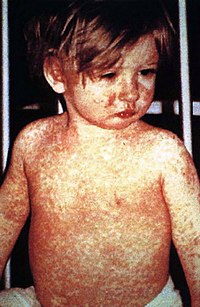
Vaccination efforts for Buruli ulcer
Sign Up to like & getrecommendations! Published in 2022 at "Expert Review of Vaccines"
DOI: 10.1080/14760584.2022.2113514
Abstract: ABSTRACT Background Buruli ulcer is one of the most common mycobacterial diseases usually affecting poorer populations in tropical and subtropical environments. This disease, caused by M. ulcerans infection, has devastating effects for patients, with significant… read more here.
Keywords: disease; vaccination efforts; efforts buruli; buruli ulcer ... See more keywords

Financial burden of health care for Buruli ulcer patients in Nigeria: the patients' perspective.
Sign Up to like & getrecommendations! Published in 2017 at "International health"
DOI: 10.1093/inthealth/ihw056
Abstract: BACKGROUND The economic burden of Buruli ulcer for patients has not been well-documented. This study assessed the costs of Buruli ulcer care to patients from the onset of illness to diagnosis and to the end… read more here.
Keywords: costs buruli; burden; buruli ulcer; care ... See more keywords

Shortening Buruli Ulcer Treatment with Combination Therapy Targeting the Respiratory Chain and Exploiting Mycobacterium ulcerans Gene Decay
Sign Up to like & getrecommendations! Published in 2019 at "Antimicrobial Agents and Chemotherapy"
DOI: 10.1128/aac.00426-19
Abstract: Buruli ulcer is treatable with antibiotics. An 8-week course of rifampin (RIF) and either streptomycin (STR) or clarithromycin (CLR) cures over 90% of patients. ABSTRACT Buruli ulcer is treatable with antibiotics. An 8-week course of… read more here.
Keywords: buruli ulcer; treatment; rif; mycobacterium ulcerans ... See more keywords

Toward a Single-Dose Cure for Buruli Ulcer
Sign Up to like & getrecommendations! Published in 2020 at "Antimicrobial Agents and Chemotherapy"
DOI: 10.1128/aac.00727-20
Abstract: A single dose of Q203 (Telacebec), a phase 2 clinical candidate for tuberculosis, eradicates Mycobacterium ulcerans in a mouse model of Buruli ulcer infection without relapse up to 19 weeks posttreatment. Clinical use of Q203 may… read more here.
Keywords: q203; toward single; single dose; buruli ulcer ... See more keywords

Impact of Temperature and Oxygen Availability on Gene Expression Patterns of Mycobacterium ulcerans
Sign Up to like & getrecommendations! Published in 2023 at "Microbiology Spectrum"
DOI: 10.1128/spectrum.04968-22
Abstract: Buruli ulcer is a debilitating skin disease caused by the environmental pathogen Mycobacterium ulcerans. M. ulcerans produces a toxic compound, mycolactone, which leads to tissue necrosis and ulceration. Barriers to preventing Buruli ulcer include an… read more here.
Keywords: expression; temperature; mycobacterium ulcerans; oxygen ... See more keywords

Perceived causes and risk factors of Buruli ulcer among patients at Agogo Presbyterian hospital in Ashanti Region of Ghana
Sign Up to like & getrecommendations! Published in 2018 at "BMC Research Notes"
DOI: 10.1186/s13104-018-3172-5
Abstract: ObjectiveThe incidence of Buruli ulcer has been recorded in about 30 countries globally and Africa seems to be the most affected area. The study sought to determine perceived causes and risk factors of Buruli ulcer… read more here.
Keywords: perceived causes; causes risk; hospital; risk factors ... See more keywords

The location of Australian Buruli ulcer lesions—Implications for unravelling disease transmission
Sign Up to like & getrecommendations! Published in 2017 at "PLoS Neglected Tropical Diseases"
DOI: 10.1371/journal.pntd.0005800
Abstract: Background Buruli ulcer (BU), caused by Mycobacterium ulcerans, is increasing in incidence in Victoria, Australia. To improve understanding of disease transmission, we aimed to map the location of BU lesions on the human body. Methods… read more here.
Keywords: transmission; buruli ulcer; disease transmission; location ... See more keywords

The incubation period of Buruli ulcer (Mycobacterium ulcerans infection) in Victoria, Australia – Remains similar despite changing geographic distribution of disease
Sign Up to like & getrecommendations! Published in 2018 at "PLoS Neglected Tropical Diseases"
DOI: 10.1371/journal.pntd.0006323
Abstract: Background Buruli ulcer (BU) is a geographically-restricted infection caused by Mycobacterium ulcerans; contact with an endemic region is the primary risk factor for disease acquisition. Globally, efforts to estimate the incubation period of BU are… read more here.
Keywords: peninsula; mycobacterium ulcerans; period; buruli ulcer ... See more keywords

Perceived water-related risk factors of Buruli ulcer in two villages of south-central Côte d’Ivoire
Sign Up to like & getrecommendations! Published in 2022 at "PLOS Neglected Tropical Diseases"
DOI: 10.1371/journal.pntd.0010927
Abstract: Background Buruli ulcer, caused by Mycobacterium ulcerans, is a neglected tropical skin disease that is primarily endemic in West and Central Africa, including Côte d’Ivoire. Studies indicate that M. ulcerans infections are caused by contact… read more here.
Keywords: water; south central; risk factors; ivoire ... See more keywords

Evaluation of the fluorescent-thin layer chromatography (f-TLC) for the diagnosis of Buruli ulcer disease in Ghana
Sign Up to like & getrecommendations! Published in 2022 at "PLoS ONE"
DOI: 10.1371/journal.pone.0270235
Abstract: Background Buruli ulcer is a tissue necrosis infection caused by an environmental mycobacterium called Mycobacterium ulcerans (MU). The disease is most prevalent in rural areas with the highest rates in West and Central African countries.… read more here.
Keywords: tlc; diagnosis; fluorescent thin; buruli ulcer ... See more keywords

Aberrant stromal tissue factor localisation and mycolactone-driven vascular dysfunction, exacerbated by IL-1β, are linked to fibrin formation in Buruli ulcer lesions
Sign Up to like & getrecommendations! Published in 2022 at "PLoS Pathogens"
DOI: 10.1371/journal.ppat.1010280
Abstract: Buruli ulcer (BU) is a neglected tropical disease caused by subcutaneous infection with Mycobacterium ulcerans and its exotoxin mycolactone. BU displays coagulative necrosis and widespread fibrin deposition in affected skin tissues. Despite this, the role… read more here.
Keywords: vascular dysfunction; factor; buruli ulcer; mycolactone ... See more keywords